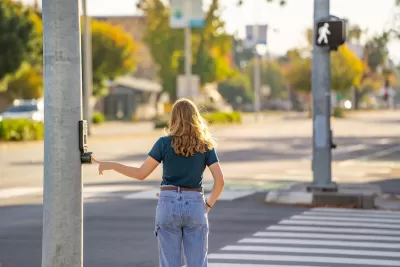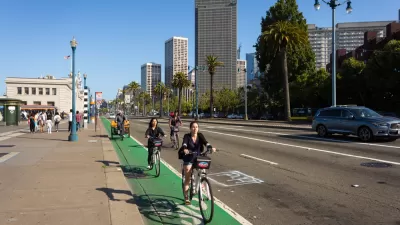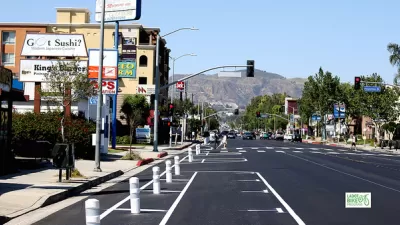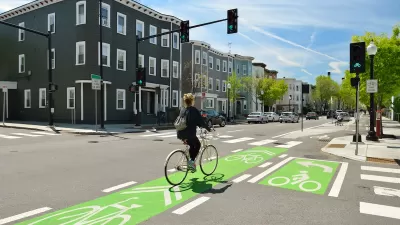The state’s transportation agency will be required to prioritize multimodal transportation infrastructure and improve transparency.

Among the many bills signed by California Governor Gavin Newsom last week is the state’s first Complete Streets law, reports Melanie Curry for Streetsblog California.
“S.B. 960 requires Caltrans to prioritize road improvements for pedestrians, bike riders, and public transit users whenever it performs maintenance or does road work. That can include sidewalks, bike lanes, bus-only lanes, comfortable and accessible public transportation stops, frequent and safe crosswalks, median islands, accessible pedestrian signals, curb extensions, narrower travel lanes, and more.” The law also calls for a “more transparent decision process” when local governments want to make safety improvements on state-managed roads, a move sometimes blocked by state agencies.
In addition to pedestrian and bike infrastructure, the bill requires Caltrans to develop a plan for prioritizing public transit, which “should make infrastructure like bus lanes and protected bus stops easier and faster to build.”
Curry notes that the law “still offers Caltrans ways to avoid doing the work that's needed,” and that local advocates must remain vigilant.
The article details another new law, AB 2086, that requires Caltrans to conduct a financial analysis of its California Transportation Plan. “Right now, this plan, which lays the groundwork for the state's future transportation system, is an ‘aspirational’ plan without any solid discussion of funding sources - nor of where current funding is being spent or could be better spent.”
FULL STORY: Governor Newsom Signs Complete Streets Bill

Alabama: Trump Terminates Settlements for Black Communities Harmed By Raw Sewage
Trump deemed the landmark civil rights agreement “illegal DEI and environmental justice policy.”

Planetizen Federal Action Tracker
A weekly monitor of how Trump’s orders and actions are impacting planners and planning in America.

The 120 Year Old Tiny Home Villages That Sheltered San Francisco’s Earthquake Refugees
More than a century ago, San Francisco mobilized to house thousands of residents displaced by the 1906 earthquake. Could their strategy offer a model for the present?

Ken Jennings Launches Transit Web Series
The Jeopardy champ wants you to ride public transit.

BLM To Rescind Public Lands Rule
The change will downgrade conservation, once again putting federal land at risk for mining and other extractive uses.

Indy Neighborhood Group Builds Temporary Multi-Use Path
Community members, aided in part by funding from the city, repurposed a vehicle lane to create a protected bike and pedestrian path for the summer season.
Urban Design for Planners 1: Software Tools
This six-course series explores essential urban design concepts using open source software and equips planners with the tools they need to participate fully in the urban design process.
Planning for Universal Design
Learn the tools for implementing Universal Design in planning regulations.
Clanton & Associates, Inc.
Jessamine County Fiscal Court
Institute for Housing and Urban Development Studies (IHS)
City of Grandview
Harvard GSD Executive Education
Toledo-Lucas County Plan Commissions
Salt Lake City
NYU Wagner Graduate School of Public Service





























